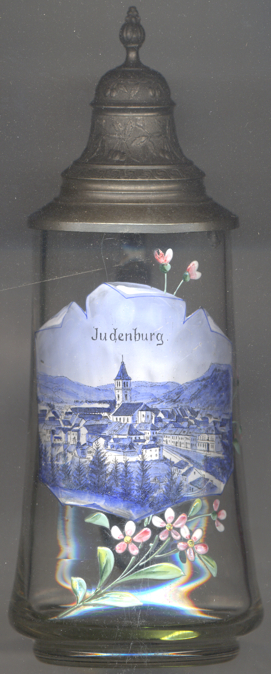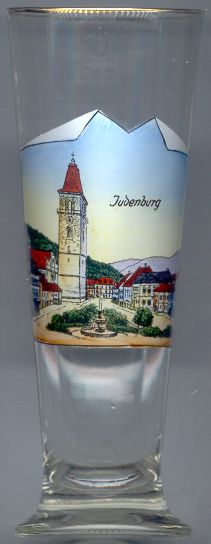

|
| ÖSTERREICH | AUSTRIA |
| Bundesland: Steiermark | Styria |
| Bezirk: Murtal |
 Judenburg is situated at an elevation of 737 m at the western end of the Aichfeld plain at the river Mur in Upper Styria.
The municipality has a population of about 10,350 (2004). Judenburg is the seat of the administration of the district Murtal.
Judenburg is situated at an elevation of 737 m at the western end of the Aichfeld plain at the river Mur in Upper Styria.
The municipality has a population of about 10,350 (2004). Judenburg is the seat of the administration of the district Murtal.
Strettweg in the vicinity of Judenburg was the site of one of the most important archeological finds in Styria, made in 1851 in a monumental princely burial mound of the Hallstatt period. The bronze sculpture represents a group of human figures on a vehicle, grouped around a female figure (32 cm) holding a bronze bowl. The object ("Strettweger Kultwagen") dates from about 600 BC. A further find was a hoard of 2,800 coins (Antoninianae) of the Roman period.
 The earliest mention of Judinburch dates from 1024 and is found in a document of the monastery of
Admont and refers to an old castle that was located in the eastern part of todays town.
The earliest mention of the market settlement, mercatum Judenpurch, dates from 1103.
In 1224 Judenburg was chartered as a town.
The old town centre around the market square was laid out in 1240.
Parts of the old fortifications of that period are still preserved today.
The earliest mention of Judinburch dates from 1024 and is found in a document of the monastery of
Admont and refers to an old castle that was located in the eastern part of todays town.
The earliest mention of the market settlement, mercatum Judenpurch, dates from 1103.
In 1224 Judenburg was chartered as a town.
The old town centre around the market square was laid out in 1240.
Parts of the old fortifications of that period are still preserved today.
The origin of the name Judenburg is not entirely clear. Although the name was mentioned as early as 1024, Jews settled here only after 1300 according to old documents. Although the Jews were expelled in 1496, the town crest, which is still in use today, shows the head of a Jew wearing a leather hat typical for Jewish men of the Medieval period.
During the Middle Ages Judenburg became one of the most important trading towns in Styria, especially due to the trading of salt and iron with Venice. The mint of Judenburg was the earliest in Austria where gold coins were struck. The Judenburg guilder was the most important gold coin of the 14th century in Austria. The tradition of iron working goes began in the 16th century. In the 19th century numerous hammer mills and scythe manufactures operated in the town. Today, Judenburg still is both an industrial and trading town.
In 1946 the district Knittelfeld was separated from the district Judenburg. On 1 Januar 2012 both districts were merged again under the new name Murtal. Judenburg remained the seat of the administration of the combined district.
The  Stadtturm [left] is the popular landmark of Judenburg.
The tower (75 m high) was built in 1449–1509 as the bell-tower of the parish church St. Nicholas.
It also had the function of a watchtower to guard against fires which repeatedly ravaged in the historic town.
The tower was heightened in 1841/1842 after it had been damaged by a large fire in the year before.
It is a rare example of a free-standing bell-tower in Austria.
Stadtturm [left] is the popular landmark of Judenburg.
The tower (75 m high) was built in 1449–1509 as the bell-tower of the parish church St. Nicholas.
It also had the function of a watchtower to guard against fires which repeatedly ravaged in the historic town.
The tower was heightened in 1841/1842 after it had been damaged by a large fire in the year before.
It is a rare example of a free-standing bell-tower in Austria.
The  parish church Sankt Nikolaus [far left] was built after 1413 in Gothic style.
It was enlarged after 1478 and rebuilt in 1504–1537. After 1670 it was remodeled in baroque style. The exterior
façades were redesigned in 1899–1902. A treasure of the church is a limestone statue of Our Lady,
created in 1420–1425 by master Hans of Judenburg.
parish church Sankt Nikolaus [far left] was built after 1413 in Gothic style.
It was enlarged after 1478 and rebuilt in 1504–1537. After 1670 it was remodeled in baroque style. The exterior
façades were redesigned in 1899–1902. A treasure of the church is a limestone statue of Our Lady,
created in 1420–1425 by master Hans of Judenburg.
![[scale]](lineal.jpg)